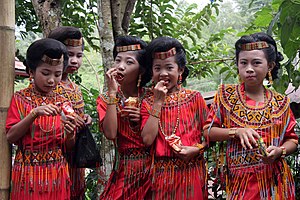
Back توراجا Arabic توراجا ARZ Toracalar Azerbaijani Тараджы Byelorussian Orang Toraja BEW Toraja Catalan Toraja German Toraya Spanish Toraja Basque مردم توراجائی Persian
To Raya, To Raa, To Raja | |
|---|---|
 Torajan girls at a wedding ceremony | |
| Total population | |
| 1,100,000[1] | |
| Regions with significant populations | |
| South Sulawesi | 600,000[2] |
| West Sulawesi | 179,846 (14% of the population; also known as Mamasa people)[3] |
| Languages | |
| Toraja-Sa’dan language, Kalumpang language, Mamasa language, Tae’ language, Talondo' language, Toala' language (vernacular languages) and Indonesian | |
| Religion | |
| Related ethnic groups | |
| Mamasa, Mandarese, Bugis, Makassar[4] | |

The Torajan are an ethnic group indigenous to a mountainous region of South Sulawesi, Indonesia. Their population is approximately 1,100,000, of whom 450,000 live in the regency of Tana Toraja ("Land of Toraja").[1] Most of the population is Christian, and others are Muslim or have local animist beliefs known as aluk ("the way"). The Indonesian government has recognised this animistic belief as Aluk To Dolo ("Way of the Ancestors") as well as Hindu Alukta, namely, a form of Hinduism in Indonesia.[5]
The word Toraja comes from the Buginese language term to riaja, meaning "people of the uplands", this cognates with the Toraja language to raya/to raja/to raa which also means "inland/upland people" or "northern people".[6] The Dutch colonial government named the people Toraja in 1909.[7] Torajans are renowned for their elaborate funeral rites, burial sites carved into rocky cliffs, massive peaked-roof traditional houses known as tongkonan, and colourful wood carvings. Toraja funeral rites are important social events, usually attended by hundreds of people and lasting for several days.
Before the 20th century, Torajans lived in autonomous villages, where they practised animism and were relatively untouched by the outside world. In the early 1900s, Dutch missionaries first worked to convert Torajan highlanders to Christianity. When the Tana Toraja regency was further opened to the outside world in the 1970s, it became an icon of tourism in Indonesia: it was exploited by tourism development and studied by anthropologists.[8] In 1977, Hinduism was introduced to the Torajans by a mission from Bali, in which thousands of Torajans converted to Hinduism. That number has been increasing sharply since then. By the 1990s, when tourism peaked, Toraja society had changed significantly, from an agrarian model—in which social life and customs were outgrowths of the Aluk To Dolo—to a largely Christian society.[9] Today, tourism and remittances from migrant Torajans have made for major changes in the Toraja highland, giving the Toraja a celebrity status within Indonesia and enhancing Toraja ethnic group pride.[10]
- ^ a b c "Tana Toraja official website" (in Indonesian). Archived from the original on May 29, 2006. Retrieved 2006-10-04.
- ^ Zainuddin Hamka (2009). Corak pemikiran keagamaan Gurutta H. Muh. As'ad Al-Bugisi. Departemen Agama RI, Badan Litbang dan Diklat, Puslitbang Lektur Keagamaan. p. 103. ISBN 978-60-287-6601-2.
- ^ Sugihandari (February 24, 2009). "Sulawesi Barat, Cermin Politik dalam Dua Masa". Archived from the original on June 20, 2013.
- ^ Bugis and Makassarese people constitute the coastal region surrounding Toraja. In fact, the term "toraja" was invented by these coastal people to refer the isolated mountainous people.
- ^ Segara 2023.
- ^ Mills, Roger F. (1975). Proto South Sulawesi and Proto Austronesian Phonology. University of Michigan.
- ^ Cite error: The named reference
Nooy-Palm1975was invoked but never defined (see the help page). - ^ Cite error: The named reference
Adams1990was invoked but never defined (see the help page). - ^ Adams, Kathleen M. (1995). "Making-Up the Toraja? The Appropriate of Tourism, Anthropology, and Museums for Politics in Upland Sulawesi, Indonesia". Ethnology. 34 (2): 143–153. doi:10.2307/3774103. JSTOR 3774103.
- ^ Adams (2006)